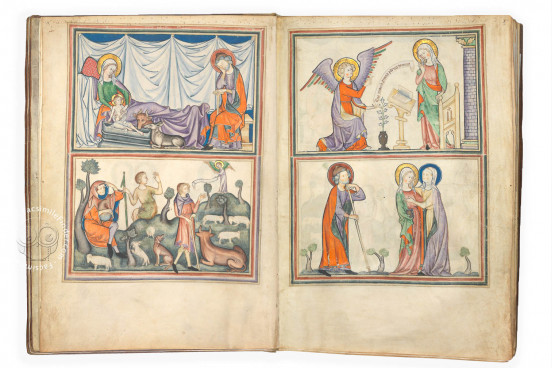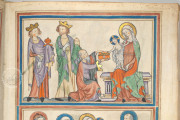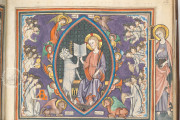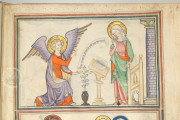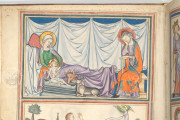The Cloisters Apocalypse is an exceptionally fine example of the elegant Gothic manuscript illumination created in Normandy in the early fourteenth century. Its text is Saint John the Divine's description of his vision of the events at the end of time that forms the last book of the Christian Bible. Its miniatures are stylistically and iconographically related to those of the Val-Dieu Apocalypse and the Apocalypse of Saint-Victor, as well as other manuscripts. The manuscript features seventy-two framed miniatures.
The Cloisters Apocalypse includes a donor portrait picturing a noble couple whose exact identity is unknown, but who may have requested the inclusion of the introductory pictorial cycle of the Life of Christ rather than the more common Life of Saint John the Evangelist, understood in the Middle Ages to have been the author of the Apocalypse.
Refined Painting
The miniatures are in a courtly, refined style with delicately shaded drapery and elegant, aloof expressions. The palette includes gold, silver, red, green, violet, blue, ocher, and brown. Gold and silver are used sparingly for halos and metallic objects, and the backgrounds are often bare parchment, but the overall effect of the miniatures' sophisticated compositions is one of monumentality.
Illustrations of the Apocalypse and the Infancy of Christ
The manuscript's half-page miniatures illustrating the text of the Apocalypse reflect the English tradition for illuminated Apocalypse manuscripts. Unusually, the book begins with a pictorial cycle of four full-page miniatures in two registers depicting eight scenes from the infancy of Christ, beginning with the Annunciation to the Virgin and ending with Flight into Egypt (fols. 1r-2v).
Originally a More Extensive Cycle of Miniatures
The manuscript has suffered the loss of eight leaves following fol. 33 that once contained Apocalypse 16:14 through 20:3 and the corresponding sixteen miniatures. The missing text was subsequently supplied on two added paper leaves at the back in a careless cursive script. The top half of folios 4 and 6 were also excised, resulting in the loss of four more miniatures.
Marginal Drawings
The Latin text of the Apocalypse is written in two columns beneath the large illustrations in a Gothic Textualis script. Each section of the text begins with a pen-flourished initial, alternating between red with violet flourishing and blue with red flourishing. The craftsperson responsible for these initials also executed delightful marginal drolleries in red and blue ink of animals, birds, and fantastic hybrid creatures.
A Rare Donor Portrait
The last image in the manuscript shows a couple kneeling, the man praying to Saint Stephen and the lady to the Virgin Mary holding the infant Jesus, who makes the sign of blessing to the lady (fol. 38v). The couple was once identified by painted coats of arms, which have been effaced. Nevertheless, the lady has been identified as a member of the Montigny family.
A Winding Road to New York
Not long after its completion, the manuscript seems to have been in the possession of the collegiate church of St. Mauritius in Zofingen. It was the possession of Robert Pecham, Thomas Darellus, Antoine de Lescazes, Etienne Cauvy, Louis-Maximien Rey, a baron Auvray, Edmond de Rothschild (1845-1934), and Alexandrine de Rothschild (1884-1965) before being acquired by the Metropolitan Museum of Art in 1968 for the Cloisters Collection.
We have 2 facsimiles of the manuscript "Cloisters Apocalypse":
- Apocalipsis de los Confinados (Cloisters Apocalypse) facsimile edition published by CM Editores, 2025
- The Cloisters Apocalypse facsimile edition published by Metropolitan Museum of Art, 1971

